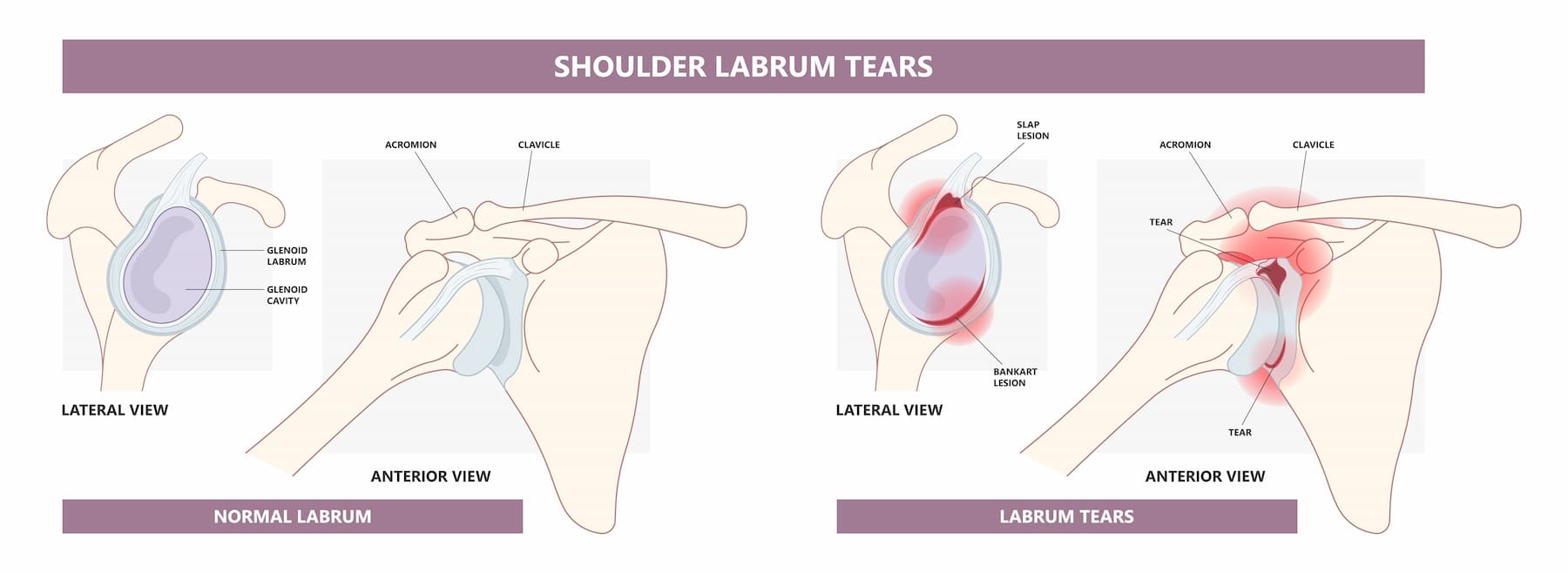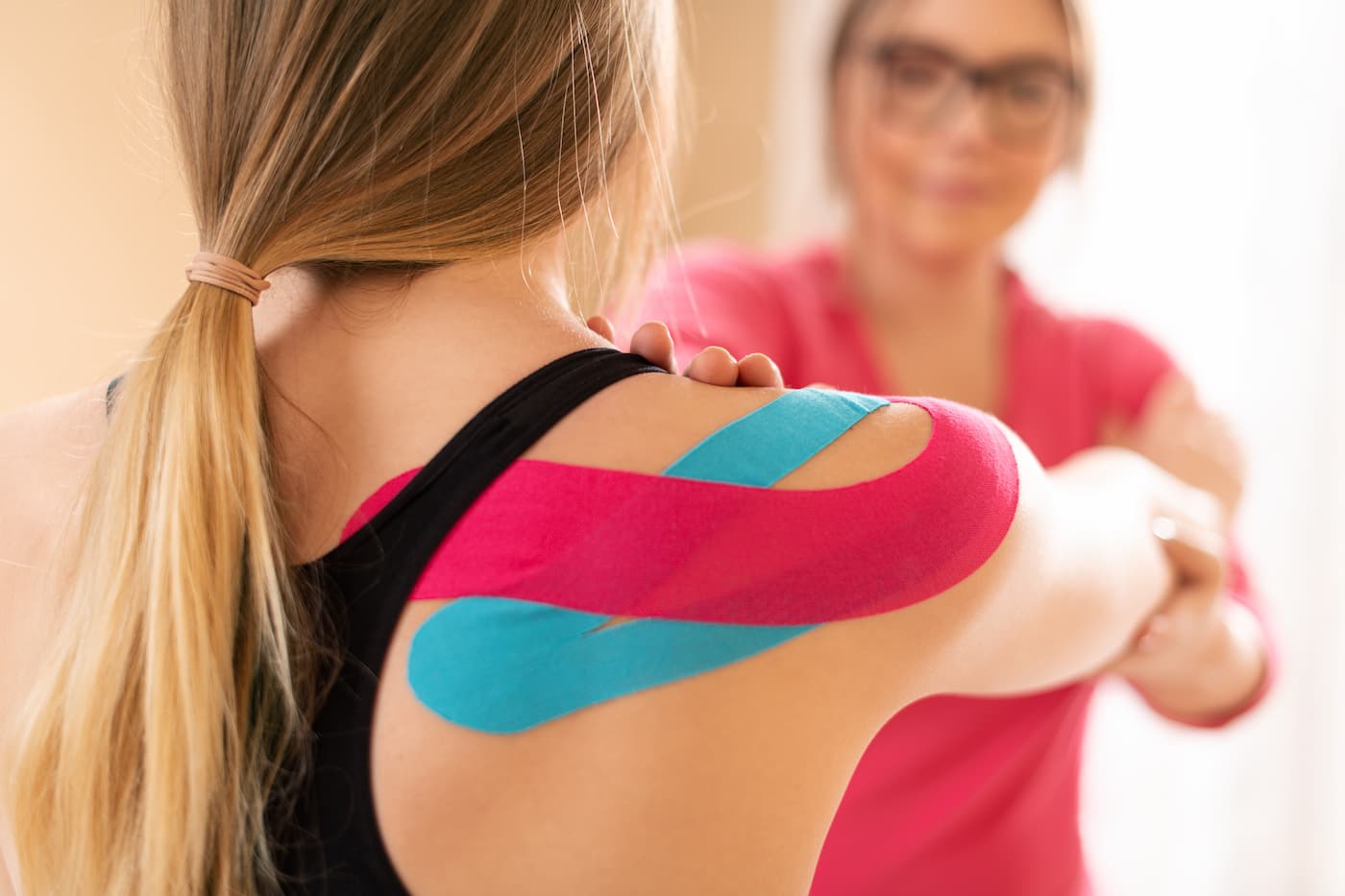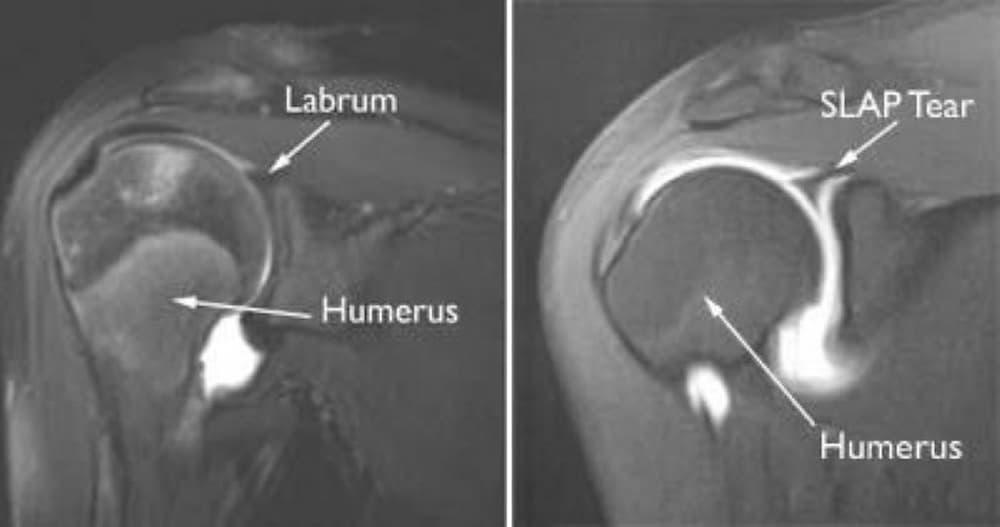Georgios Panagopoulos MD | Orthopaedic Surgeon

SLAP tears commonly occur after shoulder dislocations, in throwing athletes, and in those who perform repetitive overhead work. A SLAP tear can extend into the labral cartilage at the front or back of the shoulder. or it can even extend into the biceps tendon. Patients with a SLAP tear often report deep pain in the shoulder joint or pain that worsens with certain activities, such as throwing or working above shoulder level.
Table of contents
What is a SLAP tear?
The shoulder is the most mobile joint in the body. This allows for excellent function and movement, but also an increased risk of instability. When the shoulder is dislocated, the labral cartilage around the shoulder socket can become traumatically detached – this can happen in the front, back, or top of the socket, where the base of the long head of the biceps is located.

The labrum is a ring of connective tissue around the shoulder socket, which deepens the shoulder joint, keeping the head of the humerus in place. It works like a bumper. Any damage to the labral tissue can cause instability of the shoulder joint.
The labrum can be damaged:
In the front – Anterior
In the back – Posterior
On top – SLAP (Superior Labrum Anterior and Posterior)
In a SLAP tear, the injury involves the upper part of the labrum, where the base of the long head of the biceps tendon is attached. The tear can then extend forward or backward. Depending on the type of SLAP tear, the tissue can be folded into the joint and in more severe cases, a biceps tendon tear may occur. In some cases, patients may have a 360-degree labral tear (front, back, and top).
What causes a SLAP tear?
A SLAP tear can be caused by acute trauma, or overuse after repetitive shoulder movements. Typical conditions that cause a SLAP tear are:
- Dislocated Shoulder
- Overhead sports (throwers, weightlifting, tennis)
- Rugby and other contact sports
- Road traffic accidents
- Accidents at work
- Fall on the outstretched hand
- Overuse
SLAP tears can also occur in older patients (>40) after repeated minor trauma episodes over time. In these cases, a SLAP tear may be an incidental finding during imaging or surgery, and not the actual cause of the pain.
What are the symptoms of a SLAP tear?
SLAP damage may manifest with the following symptoms:
- Pain with movement (especially overhead)
- Sensation of locking, catching, or crepitus
- Pain with lifting overhead
- Reduced strength
- Sense of instability
- Reduced range of motion
- Difficulty throwing during sports

SLAP tear - Diagnosis
History
Dr. Panagopoulos will take a detailed history of your shoulder symptoms. He or she will ask when they first started and if there was a specific injury that caused the shoulder pain. Many patients may not remember a specific event. In some cases, work or sports may aggravate the symptoms. It is important to describe the location of the pain, as well as whether you have had physical therapy or injections in your shoulder.
Clinical exam
Dr. Panagopoulos will check your shoulder range of motion, the strength and stability of the shoulder joint. He will then perform specific movements - manipulations, to isolate the biceps tendon, and see what is reproducing your symptoms.
Imaging
The doctor will order X-rays of the shoulder to study the anatomy of the bones and rule out other possible causes of shoulder pain. The doctor will perform an ultrasound to determine the integrity of the tendons of the shoulder. He may then refer you for an MRI to study the soft tissues in more detail. If a SLAP tear is suspected, he may order an MRI arthrogram to confirm the diagnosis.

SLAP tear - Treatment
Conservative treatment
For most patients with a SLAP tear – treatment is conservative, and includes rest, activity modification, and NSAIDs. Equally important is physical therapy, to restore motion and strengthen the shoulder, which includes exercises to improve range of motion, rotator cuff & deltoid strengthening, and scapular stabilization exercises. Physical therapy can relieve pain, restore shoulder function, and prevent further injury. You may need to continue this exercise program for 3-6 months, in some cases.
Surgical Treatment
If conservative treatment fails, or it is a high-grade SLAP tear (with anterior or posterior extension), then you may be a candidate for surgery. In some cases, this may be the best option from the start. Surgery is performed arthroscopically, and may include:
- Repair of SLAP lesion with anchors
- Surgical debridement of SLAP tear and biceps tendon
- Biceps tendonitis
The factors taken into account are age, occupation, type of sport, level of athletic activity, quality of tissues. All these factors must be considered in combination to achieve the best outcome for rehabilitation. Often the final decision is made intraoperatively, that is, at the time of surgery.
Shoulder arthroscopy involves 3 4mm incisions, through which a camera and the necessary tools are inserted into the shoulder. During the surgery, the labral cartilage tear is repaired. If indicated, the tendon of the long head of the biceps is fixed in a new position so that it does not cause pain (tendon ligation). In parallel, any other coexisting shoulder conditions are corrected (such as shoulder tendon rupture).
SLAP tear - Rehabilitation
Arthroscopic treatment of SLAP lesions is a safe procedure, performed in a minimally invasive manner, with low complication rates and good functional outcome. The patient is discharged from the hospital a few hours after the procedure, wearing a sling for a few weeks. With appropriate physical therapy, the patient returns to his daily life in a few days and to sports in a few months.
FAQs - Frequently Asked Questions
What is a SLAP tear?
A SLAP tear involves the superior part of the glenoid labrum.
Who gets a SLAP tear?
It usually involves throwing and overhead athletes (throwers, tennis, weightlifting).
Find us
Book an appointment with us today
